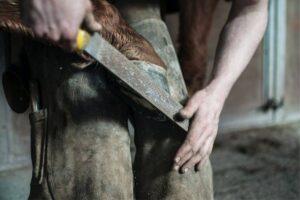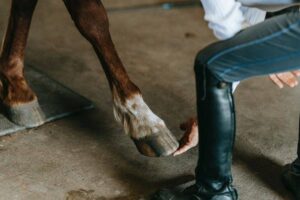Table of Contents
Horses rely on healthy hooves for most of their activities.
However, overgrown hooves or excessively short hooves can get in the way of horses having the best movement and stance.
Hoof trimming is one of the horse grooming activities that horse owners and groomers struggle with.

Unless you are experienced, it may be difficult to know when a hoof is too long, too short, or just right.
This article provides a brief insight into the ideal length of horse hooves and things to do when it’s trimmed too short.
What To Do When Horse Hoof Is Trimmed Too Short
Trimming helps prevent several hoof complications.
It also helps your horse with health risks which include situations like Podotrochlosis and laminitis, which result from poorly groomed hooves.
However, things could quickly go wrong when your owners are not experienced.
There are instances where horse owners handling horses for the first time went wrong and caused lameness in their horses.
If you have trimmed the horse hoof beyond the ideal length, the steps below would bring immediate remedy and relief.
Hooves take anywhere from a few days to weeks before they heal. However some of the steps outlined below would speed up the recovery process.
Get Experts To Help
While this article reveals a lot of do-it-yourself procedures, the first step to take when dealing with sensitive animals like horses is to get people who know how to handle things on board.
Getting an expert helps you reduce complications, especially if you are new to horses.
The kind of help you need depends on the complication that results from the trimming.
Plus, help from an expert would help you prevent future recurrence.
Apply Pads
Sometimes when the hoof is trimmed too short, padding or packing works.
It prevents the sole from coming in contact with the floor.
It also works if the hoof trimming is not smooth.
The padding also reduces the heat experienced in the sore foot.
There are several brands of packing and padding available on the market, get expert advice on the one that works best for your horse.
Use Hoof Boots
Most horse owners don’t want to hoof boots on a sore horse foot.
However, this may be a good choice, especially if you’re in transit.
If most of the remedies outlined above are not readily available, attaching horse boots to the sore foot would prevent the tender sole from coming in contact with the floor.
Apply A Mixture Of Fiberglass
Polymeric foam mixed with fiberglass is a good alternative to shoe boots.
If you don’t want to nail shoe boots to already sore hooves, clean the hoof and prepare some quantity of fiberglass with Polymeric foam.
Mix the composition well and apply it on the edges of the foot.
It would raise the sole away from the ground and prevent it from direct contact with the floor.
This method also works if you have trimmed the hood at an angle that’s not convenient for the horse.
However, performing this procedure may require some level of experience or expert guidance.
Fiberglass is solid when it’s set and may be difficult to adjust.
There is a need to get the mixture right before applying it.
Rest The Horse
As soon as you discover that your horse is reacting to a sore sole, it’s best to rest the horse.
Some unusual symptoms you’ll notice in your horse that would help you know it’s suffering from sore feet include, reluctance to move, heat in the hoof wall, lameness, etc.
Once you notice these symptoms after trimming, you may have trimmed the hoof too short.
Allow the horse to rest for some days. It helps the pain subside.
You may have to combine this step with some of the ones explained in this article to get the best results.

Allow Hoof To Grow Back Naturally
While it may be tempting to stimulate hoof growth through supplements and medications, it may hurt your horse in the long run.
Some medications come with side effects. The best practice is to rest the horse and place it on a diet that stimulates growth.
The hoof should be back to normal between a few days and weeks.
It is natural to have the horse feel hurt after excessive trimming just like human nails hurt when cut too short.
Leaving the horse to rest and heal the hoof naturally, helps it stay healthy and stable.
Monitor The Pain
Sometimes, cutting the hoof too short may not be the only problem causing pain for your horse.
Infections, scratches, side bones, bone cysts, and many other complications could also result in foot pains.
You have to monitor the pain and see how your horse responds to it.
If pain remains severe after 5 – 10 days, it may be an indication that there are other factors triggering the pain.
Horse Hoof Healing Circle
Following the steps outlined above should trigger the healing process.
Once you’ve taken steps to remedy the pains, the hoof starts to heal.
For the first few days, the sole would remain tender and the horse may be reluctant to move.
However, after the first five days, the tenderness starts recovering.
On average, horse hoof grows up to a quarter monthly.
Therefore, within four weeks, the healing process should be complete and the horse should be back on its feet.
However, if the trimming inflicts injury on the sole, it may take much longer to heal.
However, if you notice that the injury persists, you may need to invite the veterinary doctor to have a look at the condition.
Sometimes, the tenderness of the soul may have allowed for easy penetration of sharp objects like nails, broken metals, etc.
Persistent complications indicate possible complications.
The Appropriate Horse Hoof Length And Angle
Before even considering trimming horse hooves, there are two metrics to bear in mind. The hoof angle and the hoof length.
One can’t know when it’s too short if you are not aware of the ideal length.
Generally, the horse hoof should be within 45 – 50 degrees against the floor for the front foot and 50 – 55 degrees against the floor for the hindfoot.
These angles help the horse maintain the proper stance and prevent pressure on the leg muscle.
It also keeps the sole from touching the floor.
It is best to keep the 45 degree angle in mind when trimming the horse hoof.
The length of the hoof should be kept at two inches from the frog.
Overgrown hooves force the horse to walk on the balls of its feet. This could result in lameness.
Conclusion
Just like human nails and hair, horse hooves grow throughout their lifetime.
Ideally, horse hooves should be trimmed every 4-6 weeks.
Not trimming regularly could result in splits, cracks, or movement problems for the horse.
However, trimming too short also spells trouble for the horse.
When your horse hoof is trimmed too short, there are steps you must take immediately.
Most of the remedies have been outlined above.
These remedies would not cause immediate growth of hooves, but it works to ease the soreness and speed up the growth process.







